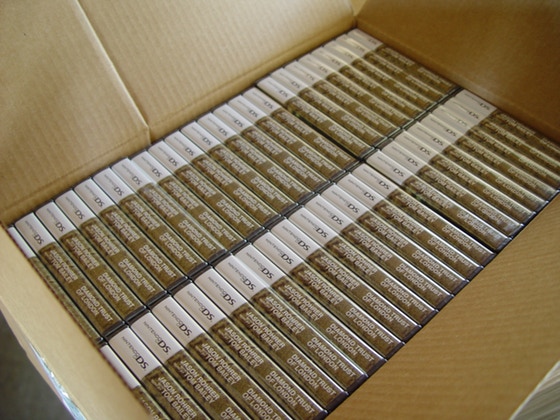Diamond Trust of London was in the right place at the right time. This unique strategy game launched on Kickstarter in mid-2012, catching a wave of popularity for both tabletop gaming and crowdfunding in general. Except, well, it didn’t really hold either of those waves.
See, Diamond Trust of London isn’t a physical board game, it’s a direct-to-digital experience for the Nintendo DS, and the timing in that regard was quite poor. Not only were mobile app stores hitting their stride with asynchronous board games, but the DS itself had already been supplanted by the 3DS more than a year earlier.
As a physical cartridge only available through Kickstarter, and later, direct sale from the designer Jason Rohrer’s website (no eShop download option here), Diamond Trust of London proceeded directly to cult status. That, and Rohrer’s garage, where over half of the 6,000 printed copies still reside. Rohrer estimates the game is on pace to sell out in approximately 100 years. All the more time for gamers to discover it. They’ll be glad they did, because Diamond Trust of London is fantastic.

Rather than rehash the mechanics of this game, here’s Rohrer’s concise summary, ripped straight from the original Kickstarter campaign:
“Diamond Trust is a two-player, turn-based, simultaneous-decision strategy game about diamond traders operating in Angola in the year 2000. Over the course of eight in-game months, diamonds accumulate in various regions to be taken by the highest bidder, and whoever brings the most diamonds back from Angola wins. Outfoxing your opponent is your main tactic, but bribing and spying mechanics complicate things. When agent loyalty waivers, your hidden information can be revealed to your opponent without you knowing that it has been revealed. On the other hand, you might know that one of your agents has been bribed by your opponent, but does your opponent know that you know?”
The real draw in Diamond Trust is that it uses its digital platform to enable game mechanisms that simply could not exist in cardboard and paper. Think of Diamond Trust as a worker placement game where workers sharing an action space can secretly bribe each other. If you bribe an enemy’s agent with more money than they’ve chosen to spend on that agent’s salary, your reward might as well be real world telepathy. All future moves (and past successful bribes!) performed by that agent will be silently revealed on your screen. This experience is not one of guessing or double guessing, it’s triple guessing, and it’s a nailbiter the whole way through.

A few other interesting elements solidify the game’s appeal. For one, it is a rare game in that it implements both-pay auctions. Bids are distributed around the board and simultaneously revealed, but both winner and loser must pay their full proposed costs. Between the constant bribing and these pricey auctions, Diamond Trust puts a serious squeeze on cash, so of course, the opportunity to earn more rests behind another precarious guessing game.
At the end of each turn, players are put into a prisoner’s dilemma where they may sell diamonds (which are VP) to earn shares of a fixed income pool. Of course, determining whether or not to sell diamonds (and how many, if so) would be much easier if a successfully-bribed opposing agent spent the turn travelling back to its HQ (an occasional necessity for agents, in order to bank their purchased diamonds). If so, your opponents cash reserves and diamond sale selection are both secretly revealed to you. Or do they know you know that…
Rohrer cites inspiration from German board games, but the cat-and-mouse of bribery and hidden information most strongly evokes the feel of Milton Bradley’s 1973 classic, Conspiracy. The Euro element is certainly present, though, as it feels more like worker placement than old-school unit movement across the map.
There is also a clear homage to Catan’s Robber, this time in the form of a UN Inspector. Workers moved to the inspector’s location have the opportunity to bribe them as well, with the highest bidder charting the inspector’s next destination (where they will interrupt that turn’s nearly-completed diamond sale, while confiscating any already-pocketed diamonds from agents along the way).

If you’re still curious about how the game works, there’s a full playthrough on Giant Bomb. What you see is what you get, as Rohrer has committed to never porting this game, stating:
“I studied the [DS] platform carefully, and thought about the “perfect” game for that platform, from my point of view. Diamond Trust is that game, and it simply does not exist separate from the platform… …This may strike some people as a strange, rigid way to go about making games—picking one platform and going full-bore on it. But I hope that other people appreciate and understand it. So, the short answer is that if I was going to make an iOS game, I would design an iOS game from the ground up. Diamond Trust will never be ported to another platform.”
Diamond Trust is both a work of art and a fascinating piece of gaming history. If it hadn’t gone through two years of publishing hoops in order to be the first (and only) indie game on a physical DS cartridge, maybe the game would have caught on. Regardless, it deserves a spot on any board gamer’s shelf.
Comments
No comments yet! Be the first!